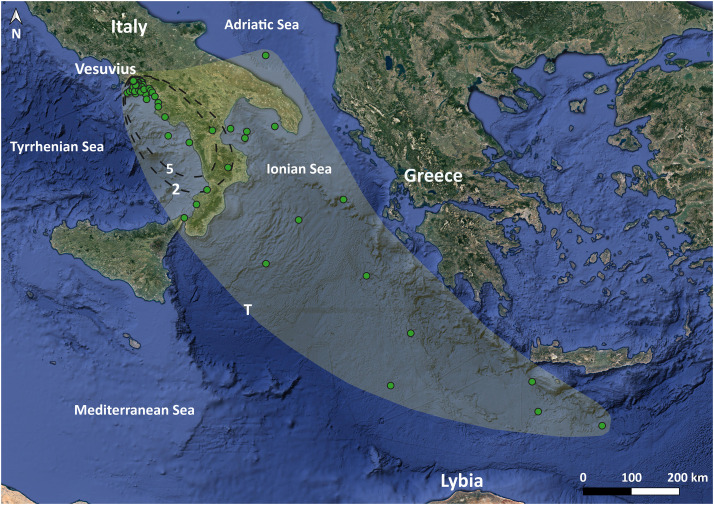A recent multidisciplinary study has rewritten the history of one of the most devastating disasters of the ancient world, the eruption of Vesuvius in 79 CE, pointing to the need for a multidisciplinary approach to volcanic research and opening new perspectives for the understanding of possible future events.
The article, published in Elsevier’s prestigious international journal Earth Science Reviews under the title “The 79 CE eruption of Vesuvius: A lesson from the past and the need of a multidisciplinary approach for developments in volcanology”, shifts the date of the devastating eruption from 24 August 79 CE, as it was believed in the past based on the description of the event made by Pliny the Younger in a letter to Tacitus, to the autumn of the same year.
A full review of the results obtained by previous studies, integrated with original data, allowed the authors to determine the exact date of the event and trace the effects of the eruption up to thousands of kilometres away, opening new research perspectives for similar events.
The study was carried out by the National Institute of Geophysics and Volcanology (INGV) in collaboration with the Institute of Environmental Geology and Geoengineering of the National Research Council (IGAG-CNR), the Interdepartmental Centre for the Study of the Effects of Climate Change (CIRSEC) and the Department of Earth Science at the University of Pisa, the Magmas and Volcanoes Laboratory (LMV) of Clermont-Ferrand, France, and the School of Engineering and Physical Sciences (EPS) at Heriot-Watt University in Edinburgh, UK.

“Our work examines different aspects of the 79 CE eruption with a broad and multidisciplinary approach, integrating historical, stratigraphic, sedimentological, petrological, geophysical, paleoclimatic and modelling data on the magmatic and eruptive processes of one of the most famous and devastating events ever occurred in the Neapolitan volcanic area,” explained Mauro A. Di Vito, INGV volcanologist and coordinator of the study. “The article starts by establishing a new date of the eruption, which would have happened in the autumn of 79 CE and not on 24 August as previously believed, it continues with the volcanological analysis of the sites in the vicinity of the volcano and then moves progressively to thousands of kilometres away, where traces of the eruption have been found in the form of fine ash.”
“The date of 24 August has been the subject of debate among historians, archaeologists and geologists since the 18th century because it seems incompatible with numerous hints of a later dating,” explained Biagio Giaccio, a researcher at IGAG-CNR, “such as the discovery of typically autumnal fruit in Pompeii or the heavy clothes worn by the victims which are not consistent with 24-25 August.” However, definitive proof of the inaccuracy of the date only emerged a few years ago. “A charcoal inscription on the wall of a house in Pompeii, which translated means ‘the sixteenth day before the kalends of November, he indulged in food in an immoderate way’, suggests that the eruption certainly occurred after 17 October,” Giaccio concluded.
The most likely date for the tragic event is 24-25 October.
The research is not limited to establishing the correct date of the disaster. The integration of field studies, laboratory analyses and the review of historical sources made it possible to trace all the eruptive phases, from the magma chamber to the deposition of ashes in areas far from Vesuvius, as far as Greece. The study was integrated with the quantitative assessment of the impact of each phase of the eruption on the areas and archaeological sites close to the volcano.
“The aim of our work was to understand how a past event can represent a window on the future, opening new perspectives for the study of possible future similar events,” said Domenico Doronzo, INGV volcanologist and co-author of the study. “This study, therefore, will make it possible to improve the applicability of forecasting models, from precursory phenomena to the impact of the various eruptive and depositional processes, but it could also contribute to reducing the vulnerability of areas and infrastructures exposed to volcanic risk, not only near the volcano, but also ‒ as this event teaches us ‒ hundreds of kilometres away from it.”
A particularly relevant and topical point covered by the research is that of the possible impact produced by volcanic eruptions on climate.
“In recent years, understanding the impact of volcanic eruptions on climate has become increasingly important also to be able to study the origin and impact of some short-lived climate variations. However, we still do not know much ‒ and with adequate resolution ‒ of the climate at the time of the 79 CE eruption,” explained Gianni Zanchetta, University of Pisa, co-author of the study.
“In this study, we tried to bring together the knowledge about the regional climatic conditions at the time of the eruption to attempt a first synthesis, also to direct future research on this aspect that still has many dark sides,” commented Monica Bini, University of Pisa.

